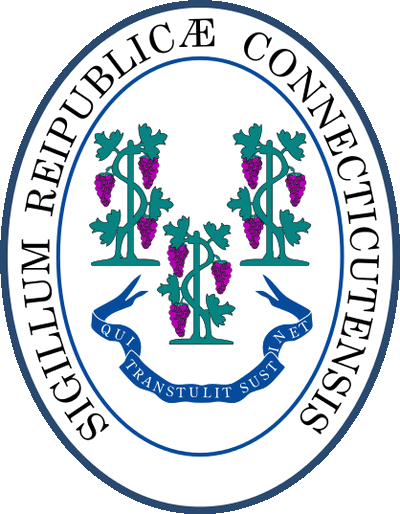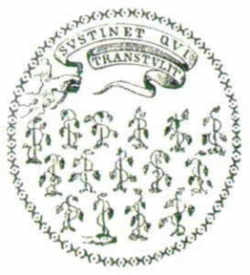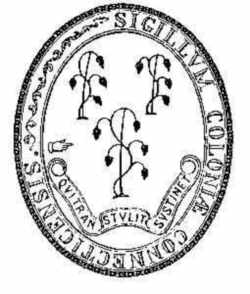

Connecticut Symbols
- » 50 States
- » Histories
- » State Symbols
- » Seals
Connecticut State Seal
Great Seal of the State of Connecticut

Adopted in 1784.
The Connecticut State Seal was adopted in 1784.
The Great Seal of the State of Connecticut has been the coat of arms of the U.S. state of Connecticut since May 1784. It depicts three grapevines and a ribbon below with the Latin motto: Qui Transtulit Sustinet (English: He who transplanted sustains), with SIGILLUM REIPUBLICÆ CONNECTICUTENSIS (English: Seal of the State of Connecticut) in the border.
The Connecticut State Seal has changed during the years, but it is similary to some of the older versions of the state's seals. The original seal had 15 grapevines on it and the motto "Sustinet Qui Transtulit"(He Who Transplanted Still Sustains). That seal was brought to this country from England in 1639. The words "Sigillum Coloniae Connecticensis"(Seal of the Connecticut Colony) were added as the seal underwent revisions in the future years.
After the Revolutionary War, as Connecticut gained statehood, the legend was changed to "Sigillum Reipublicae Connecticutensis"(Seal of the State of Connecticut). The motto "Sustinet Qui Transtulit" remains the same as on the original seal. And some of those grape vines that were a prominent feature of the older seals made it to the current seal (three are on the present one).
Connecticut Great Seal
Connecticut Seal of 1639
 Connecticut's first seal was brought from England
by Colonel George Fenwick in 1639. It was the seal of the Saybrook Colony and was turned over to the Connecticut Colony at about the time that it purchased
the land and fort at Saybrook Point from Colonel Fenwick in 1644. The seal was used by the General Court (General Assembly) from that time forward,
but there is no clear record of who had custody of the seal. On October 9, 1662, the same day that the new Royal Charter was read aloud at Hartford,
the assembly formally declared that the seal would be kept by the Secretary of the Colony and used as the Seal of the Colony on necessary occasions.
It remained the colony's seal until October 1687, when Sir Edmund Andros took control of the colony's government and the seal disappeared. It is presumed
to have been destroyed.
Connecticut's first seal was brought from England
by Colonel George Fenwick in 1639. It was the seal of the Saybrook Colony and was turned over to the Connecticut Colony at about the time that it purchased
the land and fort at Saybrook Point from Colonel Fenwick in 1644. The seal was used by the General Court (General Assembly) from that time forward,
but there is no clear record of who had custody of the seal. On October 9, 1662, the same day that the new Royal Charter was read aloud at Hartford,
the assembly formally declared that the seal would be kept by the Secretary of the Colony and used as the Seal of the Colony on necessary occasions.
It remained the colony's seal until October 1687, when Sir Edmund Andros took control of the colony's government and the seal disappeared. It is presumed
to have been destroyed.
Self-government returned to Connecticut in 1689, but for a number of years only a poorly fashioned substitute seal was used.
Connecticut Seal of 1711
 On October 25, 1711, a meeting of the Governor and
Council (upper house of the assembly) resolved, "that a new stamp shall be made and cut of the seal of this Colony, suitable for sealing upon wafers,
and that a press be provided with the necessary appurtenances, for that purpose, as soon as may be, at the cost and charge of this Colony, to be kept
in the secretary's office."
On October 25, 1711, a meeting of the Governor and
Council (upper house of the assembly) resolved, "that a new stamp shall be made and cut of the seal of this Colony, suitable for sealing upon wafers,
and that a press be provided with the necessary appurtenances, for that purpose, as soon as may be, at the cost and charge of this Colony, to be kept
in the secretary's office."
The new, less elaborately decorated seal was larger in size and more oval shaped than the original. The words of the motto remained the same, but the number of grape vines was reduced to three and the legend SIGILLUM COLONIAE CONNECTICUTENSIS (Seal of the Connecticut Colony) is added to the edge of the seal. The three vines may have been intended to represent the three colonies, New Haven, Saybrook, and Connecticut (Hartford), which, by 1665, had merged to form the Connecticut of that time.
Connecticut Seal of 1784
After the conclusion of the Revolutionary War, the inscription on the colonial seal was no longer appropriate. Therefore, in May of 1784 the General Assembly directed the Secretary to alter the inscription to read "SIGILL. REIP. CONNECTICUTENSIS." However, when a new version of the seal was prepared, the inscription contained the words spelled out ---SIGILLUM REIPUBLICAE CONNECTICUTENSIS (Seal of the State of Connecticut). There has been no subsequent alteration to the official state seal. In 1931, the General Assembly required that all representations of the state seal conform to the description in Chapter 54 of the Public Acts of that year. This legislation also prohibited reproduction of the seal except by or under the direction of the Secretary of the State.
The Connecticut State Seal is an official emblem of the State.
Connecticut Seal Law
Connecticut General Statutes, Title 3, Chapter 32, Section 3-106.
TITLE 3. STATE ELECTIVE OFFICERS.
CHAPTER 32. SECRETARY.
SECTION 3-106. Seal.
Sec. 3-106. Seal. The great seal of the state shall conform to the following description: It shall be a perfect ellipse with its major axis two and
one-half inches in length and its minor axis two inches in length, the major axis being vertical. Within such ellipse shall appear another ellipse
with its major axis one and fifteen-sixteenths inches in length and its minor axis one and one-half inches in length. The inner ellipse is separated
from the outer ellipse only by a line two points one-thirty-sixth of an inch in width and with the space between the two ellipses, being seven-thirty-seconds
of an inch, forming a border. In said space shall appear, letter spaced and in letters one-eighth of an inch in height and of twelve point century
Roman, the words "SIGILLUM REIPUBLICAE CONNECTICUTENSIS", beginning and ending one and one-sixteenth inches apart in the lower space along
such border. In the center of the inner ellipse shall be three grape vines, two above and one below, each with four leaves and three clusters of grapes
intertwined around a support nine-sixteenths of an inch high, and the base of the supports of the two upper vines one inch from the base of the inner
ellipse and eleven-sixteenths of an inch apart. The base of the lower support shall be nine-sixteenths of an inch from the base of the inner ellipse
and halfway between said bases shall appear the motto "QUI TRANSTULIT SUSTINET", in number three, six point card Roman letters, or engraver's
Roman letters, on a ribbon gracefully formed, with the ends of the ribbon turned upward and inward and cleft. A drawing of said seal shall be filed
in the office of the Secretary and shall be its official drawing.
(1949 Rev., S. 179, 8490; 1953, S. 3280d; 1959, P.A. 328, S. 2; 1961, P.A. 76, S. 2.)
History: 1959 act deleted provision confining use of seal to use under direction of secretary and stated reproductions could only be for purposes related
directly or indirectly to state business; 1961 act deleted all provisions re reproductions.






